Nov 12 2020
Black hole mergers are cataclysmic astrophysical events that can discharge energy in unforeseen forms.
 The merger of black holes could release energy in the form of ELFs (bottom left of the image). It might be possible to detect their weak signals with quantum sensor networks such as the GPS network (top right in the image). Image Credit: Sarah and Hannah Lilienthal.
The merger of black holes could release energy in the form of ELFs (bottom left of the image). It might be possible to detect their weak signals with quantum sensor networks such as the GPS network (top right in the image). Image Credit: Sarah and Hannah Lilienthal.
For instance, exotic low-mass fields (ELFs) could travel through space and make feeble signals detectable using quantum sensor networks, for example, the magnetometers of the GNOME network or the atomic clocks of the GPS network.
These are the findings of theoretical calculations performed by a team of researchers, including Dr Arne Wickenbrock of the PRISMA+ Cluster of Excellence at Johannes Gutenberg University Mainz (JGU) and the Helmholtz Institute Mainz (HIM). They are specifically intriguing in the search for dark matter as low-mass fields are considered to be potential candidates for this exotic form of matter.
From Multi-Messenger Astronomy to the Search for Dark Matter
In multi-messenger astronomy, disparate signals arising from the same astrophysical event are observed in a coordinated way. Gravitational waves were first detected using the LIGO interferometer several years ago, since then, the interest in this area of research has increased much. It has also yielded a huge amount of new information about the depths of the universe.
When gravitational waves are generated somewhere in space and detected on Earth, numerous telescopes now focus on the event to record various signals, such as those in the form of electromagnetic radiation, for instance.
Dr Arne Wickenbrock, Johannes Gutenberg University Mainz
Dr. Wickenbrock continued, “We asked ourselves what would happen if part of the observed energy released by such events was also radiated in the form of exotic low-mass fields or ELFs. Would we be able to detect them with our existing networks of quantum sensors?”
The calculations by the team have confirmed that this could be the case for specific parameters. “We also reasoned that such fields, when radiated, would cause a characteristic frequency signature in the networks,” added Wickenbrock. “The signal would be similar to the sound of a passing siren, sweeping from high to low frequencies.”
The team has two specific networks in mind: the universal GPS network of atomic clocks and the GNOME network, including huge numbers of magnetometers spread across the globe. Based on the predicted strength of the signal, the GPS system should now be adequately sensitive to detect ELFs.
The research group of JGU Professor Dmitry Budker at HIM, along with other groups, is now working to upgrade the GNOME network. Once the work is completed, it should also be adequately sensitive to observe such events.
Potential ELFs are specifically crucial in the search for dark matter. This strange form of matter has already been predicted to exist, but no one yet knows what it is composed of. Specialists are contemplating and studying a complete range of potential particles that might theoretically qualify as candidates.
Very light bosonic particles are among the most potential existing candidates and can be observed as a classic field that oscillates at a specific frequency.
Thus, in the depths of the universe, dark matter in the form of ELFs may be created during the merger of two black holes. Precision quantum sensor networks, in turn, could function as ELF telescopes, adding another important element to the toolbox of multi-messenger astronomy.
Dr Arne Wickenbrock, Johannes Gutenberg University Mainz
Journal Reference:
Dailey, C., et al. (2020) Quantum sensor networks as exotic field telescopes for multi-messenger astronomy. Nature Astronomy. doi.org/10.1038/s41550-020-01242-7.